Flux-cored arc welding is one of the industry’s favorites due to its high welding speed, high-quality welds, and ease of use. That’s why it is seeing increased use in applications throughout the world.
However, getting the best out of flux core welding isn’t always the easiest thing to do. It takes patience, practice, and the right tools to achieve a strong flux core weld.
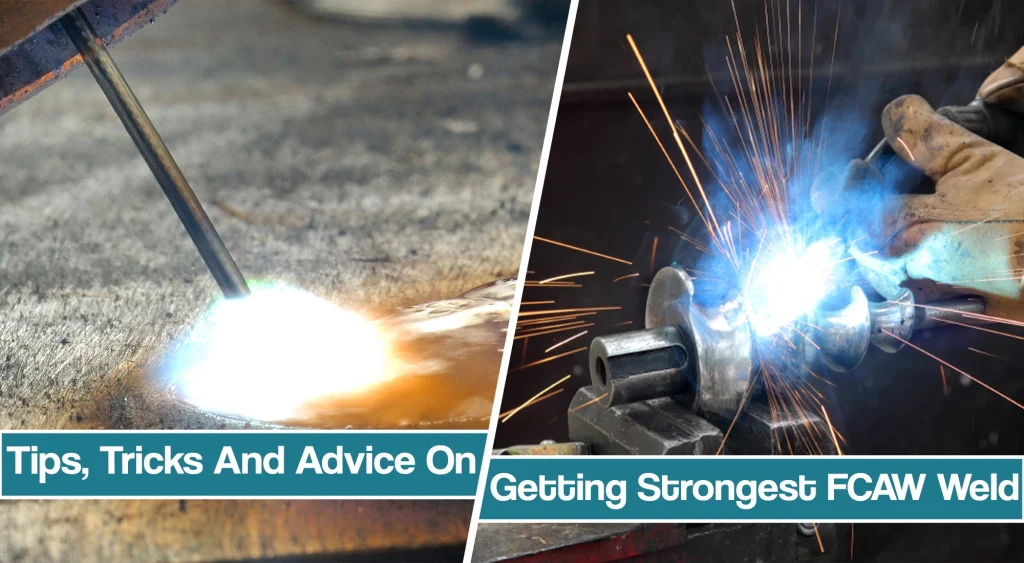
To help you understand how to get the strongest flux core weld, we will discuss the best techniques and materials to use, as well as common mistakes to avoid. You’ll learn the fundamentals of welding with flux core and master the art of creating a strong, reliable weld.
About flux core welding
Flux Cored Arc Welding (FCAW) is a welding process that uses a continuously fed consumable electrode containing a flux through a welding gun and a constant voltage power source to produce an arc.
It is a semi-automatic process that is widely used in industrial applications for its high welding speed and portability. Unlike solid wire, the flux core wire is hollow, and the flux inside the core of the wire shields the weld puddle from the atmosphere, reducing the need for external shielding gas.
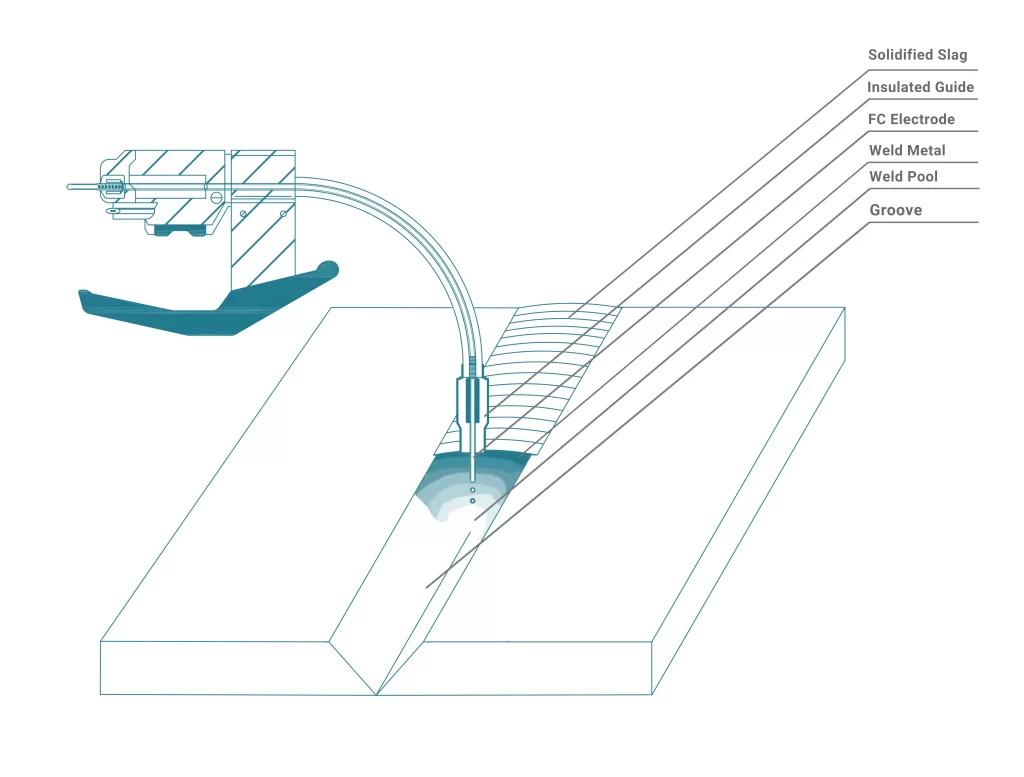
Common applications of Flux core arc welding include welding of mild steel and low-alloy steels, stainless steel, aluminum, and copper alloys. It is also used in heavy equipment repair, bridge construction, and fabrication of structural components, such as buildings and ships.
Welders choose Flux-cored arc welding and FC welders because it is a fast and economical process, similar to Stick welding. It is also easier to use than other welding processes, as it requires minimal setup and can be used with a variety of materials. In addition, FCAW can be used in all positions, making it ideal for welding in tight spaces.
Compared to MIG, flux core welding is faster, and it does not require the use of shielding gas since the flux core welding wire used in Flux core welding is self-shielding. This means that the welding arc is protected from the atmosphere, allowing welders to work in windy conditions or outdoors. Flux-cored arc welding also offers deeper penetration than MIG welding and is better suited for welding thick metal.
How to know you achieved a strong flux core weld?
You can tell if you achieved a good and strong weld by performing a visual inspection. A strong weld will have a smooth, uniform, and continuous appearance. It should have a consistent color and texture and no gaps or cracks.
The weld should also be free of slag, porosity, and other defects. The properties of a strong weld include strong mechanical strength, good corrosion resistance, and good ductility.
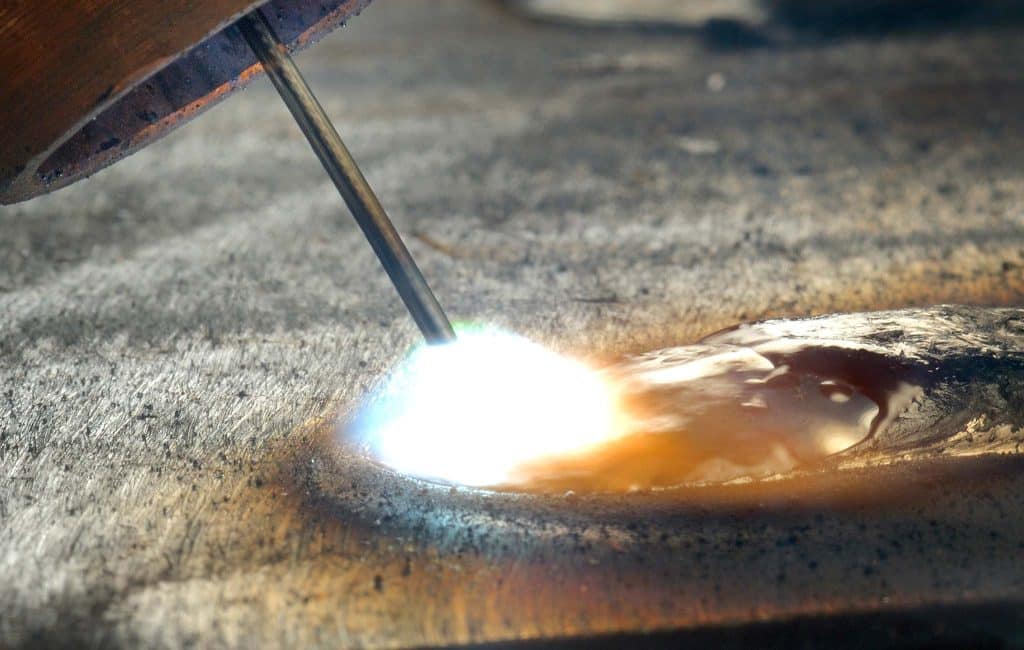
To further ensure a strong weld, you can also perform a destructive or non-destructive test. Destructive tests include bending, tensile strength testing, and hardness testing. Non-destructive tests include radiography, ultrasonic testing, and magnetic particle testing. These test welds can help you identify any flaws or defects that may not be visible to the naked eye.
Common flux core weld defects that affect the strength of the weld
Common FCAW defects include:
- Porosity: This is caused by gas entrapment in the weld pool due to inadequate shielding from the flux core. It can be prevented by using a higher current setting and a higher travel speed.
- Slag Inclusions: This is caused by the slag from the flux core not being completely removed from the weld. It can be prevented by using a chipping hammer to remove the slag after welding multiple passes.
- Undercutting: This is caused by excessive heat input or an incorrect welding technique. It can be prevented by reducing the current setting and using a slower travel speed.
- Spatter: This is caused by excessive current and/or voltage and wire speed. It can be prevented by reducing the current and voltage settings.
- Burn-Through: This is caused by excessive current and/or travel speed. It is common on thinner metals, and it can be prevented by reducing the current setting and using a slower travel speed.
The presence of any of the above-mentioned flux-cored arc welding defects can reduce the strength of the weld. Porosity can reduce the weld strength due to the presence of gas bubbles in the weld, while slag inclusions can reduce the weld strength due to the presence of non-metallic material in the weld that has different properties compared to the base metal.
Undercutting can reduce mechanical properties and weld strength due to the lack of fusion between the base metal and the weld metal, while spatter can reduce the weld strength due to the presence of small particles of molten metal on the surface of the weld. Burn-through can reduce the weld strength due to the complete melting of the base metal.
How Does A Lack Of Cleaning Impact The Strength Of The Flux Core Weld?
Weld preparation, which includes cleaning the pieces, is crucial for any welding technique, including flux core welding. Even though flux-cored wire can burn through specific contamination, it is always a good practice to clean the weld pieces. Lack of cleaning in flux cored arc welding can cause issues such as:
- Porosity: Trapped air, hydrogen, or dirt in the weld can form bubbles in the weld, known as porosity. To prevent porosity, you should make sure the surface is free of any dirt, grease, or oil prior to welding.
- Incomplete Fusion: Incomplete fusion can occur with dirty metal when the weld does not properly bond with the base material. This can be caused by poor pre-weld cleaning, which can leave contaminants on the surface that prevent proper bonding.
- Cracking: Cracking can occur due to a lack of pre-weld cleaning, which can leave contaminants on the surface that prevent proper bonding.
y properly cleaning the surface prior to welding steel or any other metal, these issues can be prevented. If you make sure everything is well prepared, you are set for a successful weld. Common ways to clean the base metal include using an old rag, wire brush, sandpaper, grinding wheel, or chemical solvents.
If the surface isn’t too dirty, you can use an old rag to remove dust or oil. Otherwise, a wire brush will remove dirt, grease, and rust from the surface. Sandpaper can be used to remove any remaining dirt or rust, but a wire brush will usually do.
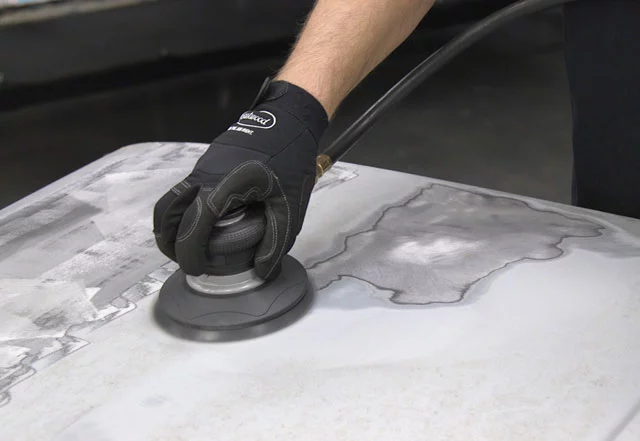
A grinding wheel can be used to create a smooth surface for welding, and that way, you are sure there are no contaminants present. Chemical cleaners or solvent solutions can be used to remove any remaining contaminants that are not removed by the other methods.
How Do Flux Core Wire Type And Size Impact The Strength Of The Weld?
Choosing the correct type and size of self-shielded flux-cored wire is essential for weld strength because the wire size dictates the size of the weld bead, and the type of wire affects the weld composition.
Matching the tensile strength and composition of the wire to the base metal is essential for weld strength. If the tensile strength of the wire is too low, the weld will be weak and may not be able to hold up to the stresses of the application. If the composition of the wire does not match the base metal, the weld may not adhere properly, leading to a weak weld.
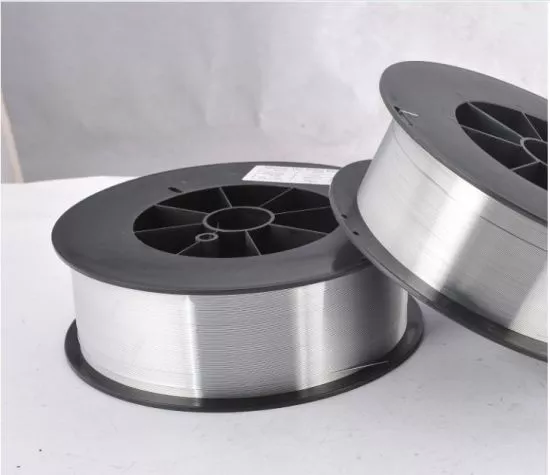
If you choose a wire size that is too small, the weld bead will be too small, leading to undercut or underfilled welds. If you choose a wire size that is larger than recommended, the weld bead will be too large, leading to a weaker weld with more spatter.
You should also make sure your flux core welding wire type matches the base metal you are welding. To avoid issues, you should always check the type and size stated by the filler metal manufacturer. They can be either carbon steel electrodes, low alloy steel electrodes, or more. In addition, check the recommended parameters on your flux core welder.
How Poor Welding Wire Feed Affects The Strength Of The Flux Core Weld?
Poor flux cored electrode wire feed can be caused by a variety of factors, including incorrect wire diameter, incorrect wire speed, incorrect voltage, or a dirty wire feeder. To deal with poor flux cored electrode wires feed, you should first check the wire diameter and speed settings to ensure they are correct.
Next, you should check the voltage to make sure it is set correctly. If the voltage is correct and the wire feed is still poor, then you may need to clean the wire feeder and connection running through your MIG welding gun.
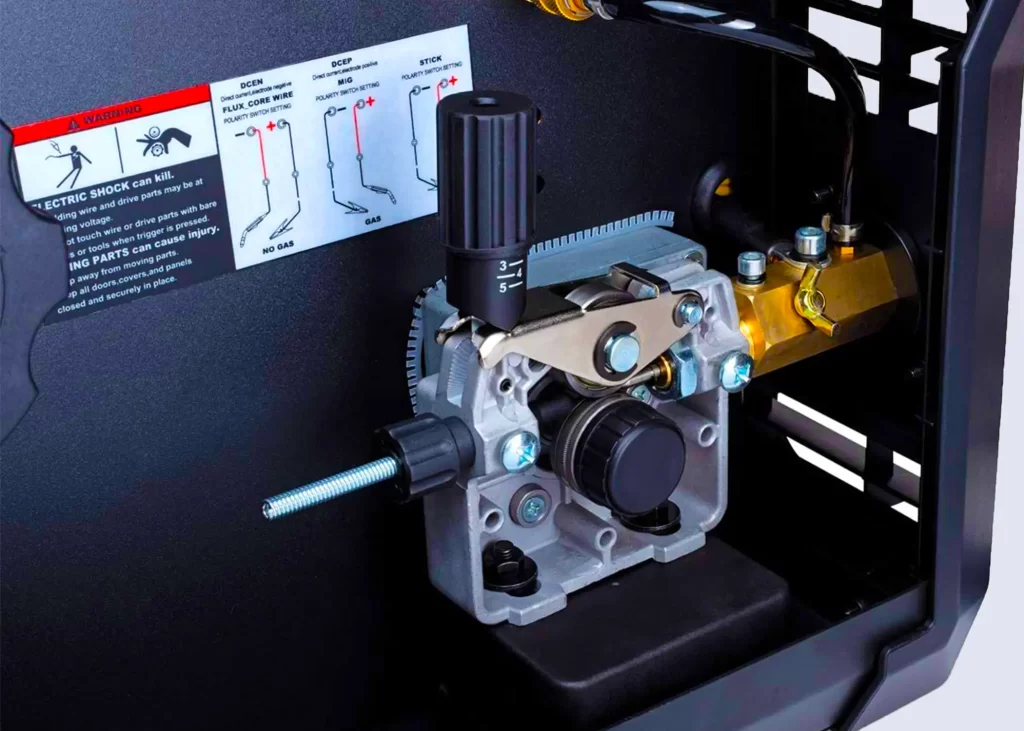
In addition, knurled rollers can be used for soft flux cored wires to help reduce wire feed problems. The knurled rollers help to grip the wire and prevent it from slipping, which helps to ensure a smooth, consistent wire feed.
Getting the smooth wire feed speed is crucial for strong flux core welds because it ensures that the wire is fed evenly and consistently. Improper wire distribution makes weld weak and inconsistent. Additionally, if the wire feed is too fast or too slow, it can cause the weld to be too hot or too cold, which can also lead to burn-through or weak welds.
If you are a beginner, getting the smooth feed can be a process of trial and error. You will have to consult the manufacturer’s recommendations or use a Flux core/MIG welder with the auto set or synergic settings that give you a head start.
How Do Weld Parameters Affect The Strength Of The Flux Core Weld?
The strength of the flux core weld is highly dependent on the parameters of the weld. If the parameters are not set correctly, the weld may be weak and prone to cracking, and you get uneven welds or burn holes in it.
The voltage is the most important parameter to get right as it controls the amount of heat created during the weld.
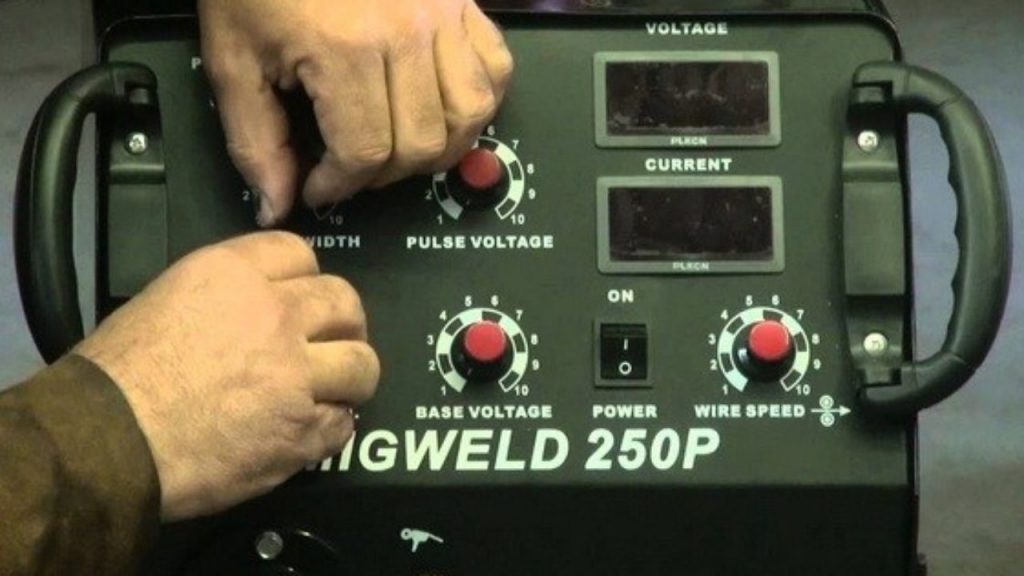
Too little voltage will result in an incomplete weld, while too much voltage can cause the weld to be too hot and cause warping, burn-through, or cracking. The wire feed speed is also important as it controls the amount of filler material added to the weld. Too slow a speed can result in incomplete welds, while too fast a speed can cause the weld to be too cold and not penetrate the base material.
Finally, the amperage is important as it controls the amount of current used during the weld. Too little amperage won’t be able to penetrate the weld metal, while too much amperage can burn holes, so you want to get a sweet spot in between.
The best way to get the parameters right every time is to use a welding machine with adjustable settings and to practice welding on scrap metal until you have a good feel for the controls. Additionally, it is important to use the correct type of filler material and the right welding equipment for the job, as different materials and metal thickness require different parameters.
If you struggle to make a strong and smooth weld, among others, make sure you check your polarity. Nearly all MIG welders have, by default, set DCEP (electrode positive) polarity, which is suitable for MIG welding. Meanwhile, the flux core requires DCEN (electrode negative) or straight polarity. Flux core welding with DCEP results in a highly inconsistent arc with lots of spatter, high ropey beads, and lack of penetration.
How Can The Improper Welding Technique Impact The Strength Of The Flux Core Weld?
Improper welding technique can have a major impact on the strength of a flux core weld. The most common mistakes include incorrect travel angle, incorrect working angle, and incorrect pushing or pulling direction.
Travel angle is the angle at which the FC welding torch moves along the weld joint. The correct travel angle is generally between 10 and 15 degrees. This angle should be kept consistent throughout the weld. If the angle is too steep, the weld can be too deep and have too much penetration, while if the angle is too shallow, the weld can be too shallow and have insufficient penetration.
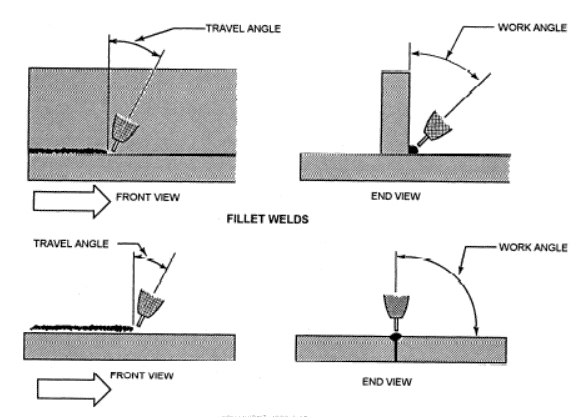
The working angle is the angle at which the MIG welding torch is held relative to the weld joint. The correct working angle for a horizontal position is generally between 45 and 60 degrees on fillet weld. For a vertical position, the angle should be between 15 and 45 degrees. For an overhead position, the angle should be between 15 and 45 degrees.
The correct pushing or pulling direction depends on the welding position. For a horizontal position, you should push away your MIG gun. For a vertical position, welders should pull. For an overhead position, you should use a push technique. Proper welding techniques can make or break your flux-cored welding project.
Final Thoughts
Getting the strongest, high-quality flux core weld can be hard, but following the steps outlined in our article can help you deal with common issues. The key steps in overcoming the challenge are preparing the pieces, choosing the right wire, welding parameters, and ensuring a good wire feed with a proper technique.
Yes, it will take you some time to get everything right as a beginner, but by mastering all these, you are set for successful flux-cored arc welding, which carries a unique set of advantages.
Resources:
- https://www.millerwelds.com/resources/article-library/flux-cored-welding-the-basics-for-mild-steel
- https://www.twi-global.com/technical-knowledge/faqs/flux-cored-arc-welding-fcaw
- https://www.welding.com.au/resources-articles/view/busting-myths-about-flux-cored-wires
- https://www.tregaskiss.com/tips-for-avoiding-common-flux-cored-problems-improving-your-fcaw-welds/





